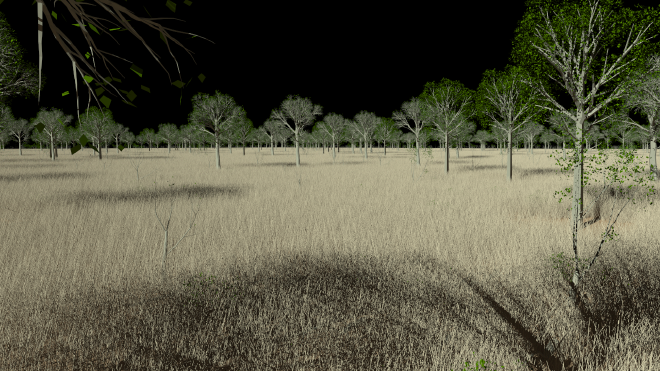The "Savanna pre-fire" scene

This scene is assembled using data from the “Savanna pre-fire” scene in the RAMI-V benchmarking exercise, developed from detailed field measurements made at experimental burn plots in the Kruger National Park, South Africa. Detailed structural and field measurements were processed to generate a 100 m × 100 m savanna model based on the work of Disney et al. (2011).
The 3D models are adapted from data made available to the scientific community by the DART development team. The spectral data presented by Disney et al. (2011) are used directly by Eradiate. The 100 m × 100 m scene model is padded with clones of itself. All renders are RGB composites using monochromatic computations at 660, 550 and 440 nm, with the sun illuminating the scene with a 60° zenith angle. The first render (black sky) features no atmosphere.

The central render (clear sky) features a plane-parallel atmosphere configured with the U.S. 1976 atmospheric profile and a continental aerosol layer with an optical thickness equal to 0.1 at 0.55 μm.

The final render features a biomassburning aerosol layer with an optical thickness equal 0.3 at 0.55 μm and the same atmospheric profile as the clear sky render.

As the total optical thickness of the atmosphere increases, the amount of scattered light in the scene increases and the shadows cast by the sun illuminating the vegetation dim out at the bottom of the atmosphere.
References and acknowledgments #
- The full presentation of the “Savanna pre-fire” scene on the RAMI-V website
- The original publication introducing the scene: Disney, M.I., P. Lewis, J. Gomez-Dans, D. Roy, M.J. Wooster, and D. Lajas. 2011. ‘3D Radiative Transfer Modelling of Fire Impacts on a Two-Layer Savanna System’. Remote Sensing of Environment 115 (8): 1866–81. https://doi.org/10.1016/j.rse.2011.03.010.
- We thank the DART development team for making the pre-processed 3D models for the Savanna pre-fire scene available to the scientific community.